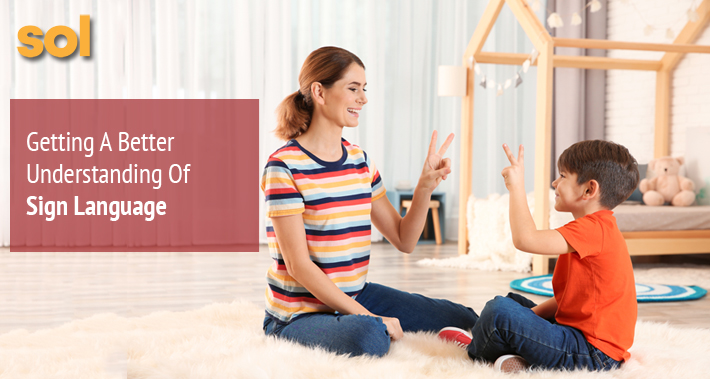
If you or your child have issues with verbal communication, it may be beneficial to consider learning sign language to be able to express your thoughts and feelings more clearly.
American Sign Language, or ASL, uses your hands as a way to communicate through forming signs.
Using ASL isn’t just for people who are deaf.
Both adults and children with certain speech disorders can use it.
Conditions such as Down syndrome, cerebral palsy, autism spectrum disorder, and many more, can impact your ability to speak effectively.
In these cases, ASL can be a useful alternative method to communicate.
Speech therapy can be very beneficial in developing both verbal and nonverbal communication skills.
At Sol Speech, our speech therapy clinic offers speech related therapy for a variety of conditions that may be limiting your speech.
So what exactly is American Sign Language and how does it work?
Let’s take a closer look and find out.
What Is American Sign Language?
American Sign Language, commonly referred to as ASL, is a method of nonverbal communication that uses your hands to form signs.
ASL is a language in which the signs you make have meaning, similar to spoken words.
Although, your hands aren’t the only thing that convey meaning in sign language.
Meaning is also conveyed through your eyes, head and body movements, and facial expressions.
Facial expressions are used to note the tone and rhythm of what you’re communicating.
It’s important to remember that American Sign Language is its own unique language and doesn’t directly mirror spoken English.
It has its own set of rules for grammar and vocabulary to communicate thoughts and ideas.
This is because sign languages developed within deaf communities that are separate from spoken language.
There are actually many forms of sign language outside of ASL.
Each with its own unique rules and methods of communication that were developed across many deaf communities around the world.
Who Invented American Sign Language?
The act of communicating using our hands has been around before formal language even existed.
In prehistoric times, early humans used hand signs and facial gestures to communicate with each other.
Even now, as babies and children we use our hands and movements to point, grab, and suggest joy or disapproval.
American Sign Language, as we know it today, began with a French priest by the name of Charles Michel De L’Epee.
He established a free public school for the deaf in Paris and translated the French alphabet into a sign language dictionary.
This dictionary incorporated ideas, concepts, and gestures rather than simply letters.
Inspired by French Sign Language, Thomas Hopkins Gallaudet, alongside Laurent Clerk, a deaf sign language teacher, developed American Sign Language in the 1800’s.
Together they established the first American school for the deaf, and made ASL its own unique language.
ASL has further developed across the world and has evolved from community to community.
Is Sign Language Just Using Signs For Spoken English Words?
No, it’s much more complex than that.
Not every word in English has a direct sign that relates to it.
However, ideas that are expressed in English typically do have a sign language counterpart.
Sign language has its own grammatical rules that go beyond the signs your hands make.
And these rules don’t align with spoken language.
Specific body movements, eyebrow and eye positions, and gestures and facial expressions all contribute to grammar and tone in sign language.
It can be difficult to find a specific word when you’re learning sign language.
In this case, it’s a good idea to take a moment and think about the idea or feeling that you’re trying to convey.

Can Babies Learn Sign Language?
Babies naturally communicate through signing and gestures before they develop spoken language.
Things like pointing, reaching, grabbing, and nodding their heads in disapproval or approval are all methods of nonverbal communication.
Babies who are exposed to signing at home are able to learn and develop signing skills similar to developing spoken language.
Through natural interactions with someone who is signing, babies are able to pick up on and imitate those signs.
Their initial signing may seem cute and humorous.
However, it will eventually develop into them using more complex hand signs and applying rules of grammar.
Can Babies Learn Sign Language And Spoken Language?
There is sometimes worry that a baby or young child learning sign language can cause delays in their speech.
However, this is not the case.
Sign language isn’t just restricted to the deaf community.
Learning sign language can be beneficial for hearing children, especially if they have conditions that can delay or limit their ability to speak verbally.
It’s also helpful if they have a deaf parent, sibling, or other close family member.
Sign language doesn’t negatively impact speech development, but rather it can help it.
It allows them to have conversations through different methods and enables the communication of thoughts, ideas, and desires.
That’s true even if they have a speech delay.
Are There Other Sign Languages?
There are many sign languages that are used across the world that have many differences from one another.
ASL itself is derived from an older version of French Sign Language.
Sign languages differ from one another because they develop independently among different groups.
As a result, there are numerous variations of sign language that continue to evolve throughout different global communities.
Some examples of diverse sign languages include French Sign Language, Australian Auslan, and BSL from England.
Does ASL Count As An Actual Language?
ASL is its own unique language with its own set of vocabulary and grammar that’s independent from spoken English.
It was specifically created by and for deaf people to be able to communicate with each other.
Sign language doesn’t mirror spoken language and uses various visual cues to create meaning that go beyond hand signs.
Things like your facial expression, eye movement, and body language all contribute to what you’re trying to convey.
Different types of sign language also have their own unique variations and are different from one another.
Are There Speech Disorders In ASL?
There are conditions that can affect a person’s ability to effectively communicate using sign language.
A traumatic brain injury or stroke, for example can affect your ability to create signs.
In these cases, a deaf person may not be able to correctly form signs or use them in proper grammar due to their physical disability.
Regardless of their limitations, speech therapy can help.
Book Your Appointment With Sol Speech And Language Therapy Today
Sign language can be a very helpful tool to assist you or your child in communicating more effectively.
If you or your child have a condition that impairs your speech or causes a speech delay, we can help.
At Sol Speech, our licensed therapists will work with you or your child to address your communication challenges.
Book your appointment with Sol Speech And Language Therapy today.
6448 E Hwy 290 Suite E-108,
Austin, TX 78723
(512) 368-9488
» https://g.page/r/CfRfhOpEQm7BEAE
Sol Speech & Language Therapy
555 Round Rock W Dr E-221,
Round Rock, TX 78681
(512) 808-3953
» https://g.page/r/Cb5pwCTosSEfEBM
Sol Speech & Language Therapy offers personalized skilled intervention to those struggling with their speech and language skills. Services offered include screening, consultation, and comprehensive evaluation. We also provide one-on-one and/or group therapy for speech sound disorders, receptive/expressive language delay/disorder, stuttering/cluttering, accent reduction, and much more.